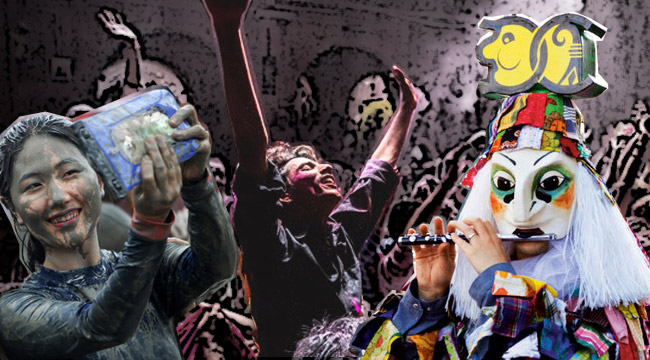
Summer is right around the corner — the time of year when feet are itchy, the travel bug is biting, and the impulse to be young, wild, and irresponsible is high. But not everyone wants to spend their hard earned cash on Coachella or Burning Man, especially not with so many free parties to attend the world over.
If you’re planning on going somewhere, but don’t want to shell out for a booze cruise or cover charges, we’ve got you covered:
Full Moon Party – Koh Phangan Beach, Thailand
Every month, anywhere between 8,000 and 30,000 people gather together on Koh Phangan beach to celebrate the new full moon. The tradition started back in 1985, when the first party of its kind was improvised at the Paradise Bungalows on the beach at Haad Rin. Word-of-mouth spread fast, and before long it had become a huge destination for those traveling through Southeast Asia. These full moon parties typically last until the morning light, with all the local bars keeping the drinks flowing and the music playing until the sun rises over the Gulf of Thailand.
La Tomatina -Buñol, Spain
One of the world’s largest food fights is held every year on the last Wednesday in August. It’s said to have started in 1945 at the Gigantes y cabezudos (which roughly translates into Big and Giant Head) parade when a group of kids started messing around and caused someone to fall from a parade float. The fall threw the offended party into a fit of rage, and the fight spilled out to the local fruit stand. The following year, this same incident was repeated, only people came with their own tomatoes from home. Since then, the festival would be occasionally banned by local police for safety concerns until it became an official holiday in 1957. The party starts each year at 9 AM when residents drop soapy water on attendees from their balconies, and by 11 AM, the first truck loaded with produce ammunition rolls through the square, and the free-for-all tomato fight commences.
Fasnacht, Switzerland
Switzerland’s annual celebration is known as die drey scheenschte Dääg, (the three most beautiful days), and it begins on the Monday after Ash Wednesday. Unlike a lot of parties on this list, Fasnacht has a clear line between passive spectators and active participants, with the latter wearing elaborate masks and costumes while carrying large, wooden lanterns that are several feet tall. The party itself gets going on Monday at 4:00 AM, and lasts for exactly 72 hours, when anywhere between 15,000 to 20,000 masked participants, known as Cliquen, wander through the town playing carnival music with thousands of spectators following close behind.
Holi, Northern India
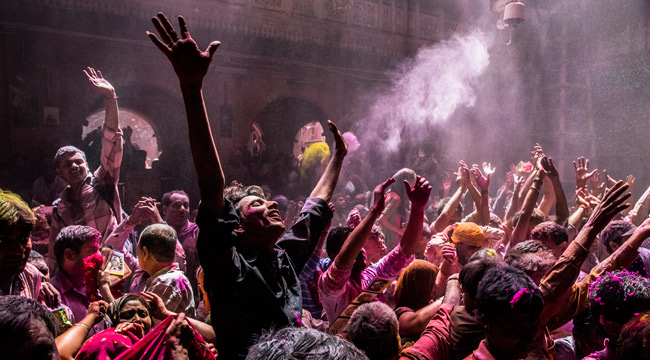
We’ve talked about the Holi Festival before, which is quickly turning into a global phenomenon, though it can trace its origins to India and Nepal. It celebrates in the lunar cycle of Falgun, which usually falls somewhere between the end of February and the middle of March every year. The colorful event is seen as an annual triumph of good over evil, as well as an event that bridges the gaps between social classes, where people from all walks of life can gather in the streets to hug while wishing one another a “Happy Holi.” As it continues to grow, celebrations for Holi have starting to spring up all over Europe and Asia, with non-Hindus eagerly participating in a celebration of love, compassion, and vibrant color.
Bay to Breakers – San Francisco, CA
The famous footrace held on the third Sunday every May is far from conventional, attracting upwards of 100,000 participants in a single year. Many of the race runners never register officially, instead opting to wear elaborate costumes, enjoying a leisurely pace behind the registered competitors while taking in all the events that pop up along the route. The event concludes with the Finish Line Festival, where spectators and participants (officially registered or otherwise) gather to listen to music and celebrate the city’s tradition that goes back more than 100 years.
St. Patrick’s Day – Dublin, Ireland
A holiday that most of us associate with excessive amounts of green beer, the city of Dublin, Ireland officially decreed the St. Patrick’s Day Festival in 1995, with the intention of creating an event that’s popular the world over, and one that the people of Ireland can stand proudly behind. The party, which is held over 4 or 5 days in March, is the country’s attempt to redefine what St. Patrick’s Day means both nationally and internationally. Along with the usual pageants and parades, much of time is spent engaging with the country’s youth about ways they can preserve their traditions and move Ireland forward together.
Australia Day – Australia
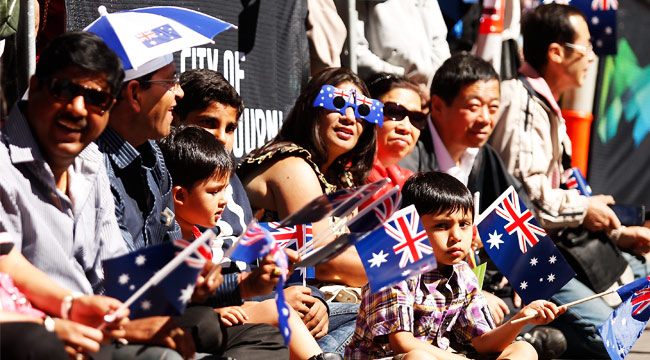
This country-wide celebration falls on January 26th every year, marking the anniversary of the First Fleet of British Ships in New South Wales in 1788, though it wasn’t recognized as ‘Australia Day’ until 1935. Even then, it took almost sixty years before the country began to celebrate it as an officially recognized holiday. For many years, that date was also celebrated by Australia’s indigenous population to mark the invasion of their country by Europeans. Since then, it has been used to encourage reconciliation and help all Australians understand their collective past while working toward their shared future. It’s celebrated all across the continent, and boasts massive gatherings, fireworks, and parades big and small.
Mardis Gras – New Orleans, LA
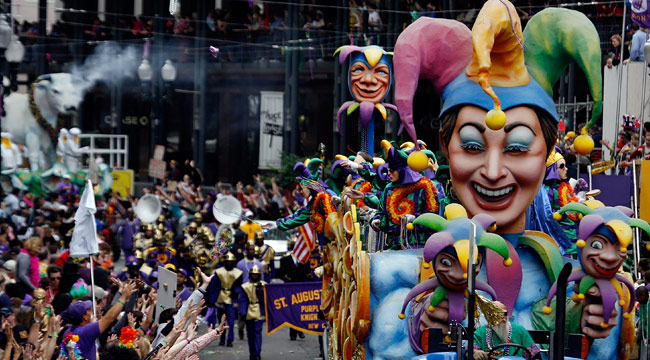
One of the most recognized parties on Earth, Mardis Gras is a celebration that lasts for days on end before culminating with Fat Tuesday, the day before Ash Wednesday, which is the start of Lent. While it has been celebrated in Europe for centuries, its origins in New Orleans can be traced back to 1699, when explorer Jean Baptiste Le Moyne Sieur de Bienville, on the eve of Mardis Gras, landed 60 miles south of where New Orleans would one day stand. He named the landing spot Pointe Du Mardis Gras, and in 1703 Fort Louis de la Mobile celebrated the first incarnation of the holiday in the new world. New Orleans would make it official until 1875 with the signing of the Mardis Gras act.
Today, the event takes over the city, with costumes, parades, and debauchery while boasting gleeful disregard for social conventions.
Battle of the Oranges – Ivrea, Italy
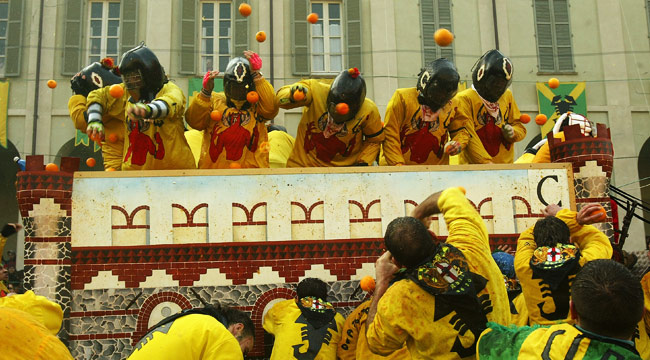
Another food fight-themed party, this time in Northern Italy, the Battle of the Oranges origins are thought to go back to sometime around the 12th or 13th century. Unlike Spain’s La Tomatina, which is a chaotic free-for-all, the Battle of the Oranges is heavily structured, with nine teams competing directly against one another. Crowds gather in the tens to hundreds of thousands to watch these nine teams take on one-another. The Battle begins on a Sunday at 2 p.m., ending on the day of Mardis Gras, while an official judge assesses the damages, eventually rewarding the winning team.
Boryeong Mud Festival – South Korea
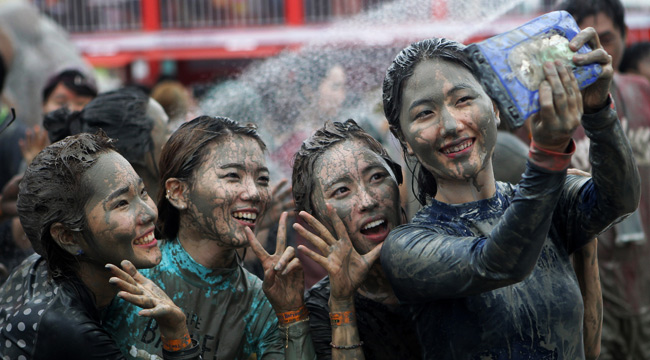
Starting out small back in 1998, within ten years the Boryeong Mud Festival now attracts more than 2 million visitors annually. The celebration is held over a two-week period, with the last weekend being the most popular time to attend. Huge amounts of mud are trucked in from the nearby Boryeong mud flats to the Daecheon beach, where it’s then used for mud fights, mud skiing, mud baths, and mud swimming in the mud mega tub — pretty much all things mud. Each night is capped off with live music and fireworks before starting up again the next day.






